Live Fire Training
Purpose Built Structures
In their article Realistic Live Burn Training You Can Afford published in the May 2009 issue of Fire Engineering, Kriss Garcia and Reinhard Kauffmann extolled the advantages of constructing a panelized wood frame structure lined with several layers of 5/8″ sheetrock (see Figure 1) as an alternative to other types of structural live fire training props and facilities. I have to admit; I am intrigued by the potential advantages of this prop for demonstration of the influence of horizontal ventilation (both natural and positive pressure) and tactical training in fire attack operations. However, I am not convinced that this prop is universally superior to other types of purpose built structures used for live fire training. Choice of live fire training facilities needs to consider a range of factors including intended learning outcomes, cost (both initial and life-cycle), and environmental considerations and constraints.
Figure 1. Build and Burn Single Family Dwelling
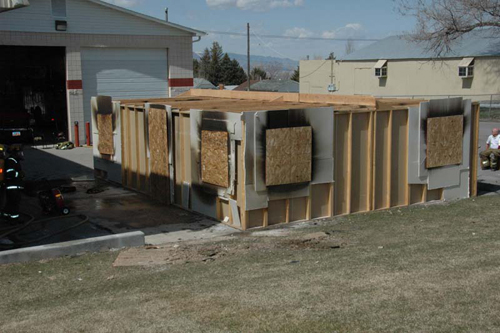
Photo provided by Kriss Garcia (positivepressureattack.com)
Response to Garcia and Kauffmann
The most important factor to consider in design, selection, and use of live fire training props and facilities is that all live fire training is a simulation. The fire is real, but the fuel load and conditions are managed to create a specific effect (unlike in the “real world”). This does not necessarily mean that the training is ineffective, simply that each evolution is intended to provide the participants with a specific opportunity to learn and develop skills.
Having conducted a substantial number of live fire training exercises in purpose built props and acquired structures, I have found that each has its advantages. Kriss and Reinhard are particularly critical of props constructed from steel containers. They state that these type of props do not provide a realistic context for showing fire development or honing fire tactical skills. I would respectfully disagree with several caveats. 1) A single compartment prop (such as a demonstration or attack cell) is not designed or intended for tactical training. This type of prop is designed to provide a safe and effective environment to demonstrate fundamental fire development in a compartment and the opportunity for learners to practice nozzle technique. 2) Multi-compartment container-based props do provide a reasonable context for tactical training with interior doors, obstructions, potential for varied fire location, etc. However, as with all other types of prop using Class A fuel (including the build and burn structure), the fuel load and configuration is considerably different than in an actual dwelling or commercial structure. Kriss also points to the severe fire conditions and damage to both equipment and participants when working in container based props. This is the result of inappropriate use, not a defect in the type of prop used. Conditions are set and controlled by the instructors.
I have greater agreement with Kriss’s and Reinhard’s observations on high-tech gas fired props in that they often fail to replicate key fire behavior indicators and may not respond appropriately to ventilation and application of water, providing poor feedback to the learners on their performance.
I also agree with many of Kriss’s and Reinhard’s observations on acquired structures. However, their example illustrating “unpredictable fire behavior” due to medium density fiberboard that had been plastered over, resulting in ignition of pyrolysis products behind the attack crew is inaccurate. This fire behavior was entirely predictable, but unanticipated (the big difference here is that unanticipated fire behavior is simply the result of a lack of information on the part of the instructors, not by random action by the fire). Kriss states that when working with acquired structures, you need to strictly adhere to the requirements of NFPA 1403. This may be a bit misleading in that this standard applies to all live fire training (including use of the build and burn structure).
Kriss and Reinhard make a good case for the ideal live fire training structure. However, it is critical to also give some thought to the intended purpose of the building or prop. Single compartment props (regardless of what they are constructed out of) may be a tremendous tool for practicing door entry and nozzle technique much like a putting green or driving range when practicing golf. The putting green and driving range are useful tools in developing specific skills, but they are not the game of golf. The ideal live fire training prop is designed to provide a means to safely, effectively, and efficiently achieve specified learning outcomes. Much the same as there is no single tactic that will solve all problems presented on the fireground, there is no single type of live fire training prop that provides the ideal context for all types of live fire training evolutions. Again, it is critical to remember that all live fire training is a simulation. The key is to provide an adequate degree of physical and functional fidelity (look real enough and behaves real enough) to achieve the intended learning outcomes.
Intended Use and Learning Outcomes
Pilots in the United States Air Force follow an exacting course of study which includes classroom instruction, simulation, and flight instruction in trainer aircraft such as theT6 and T38 before progression to more advanced aircraft such as the F22 Raptor. Each simulator and aircraft used in this progression is intended to provide the pilot with a specific learning context. After transition to high performance aircraft, pilots continue to use simulators to practice skills that may be too high risk to perform in flight.
Figure 2. T6, T38, & F22 Aircraft
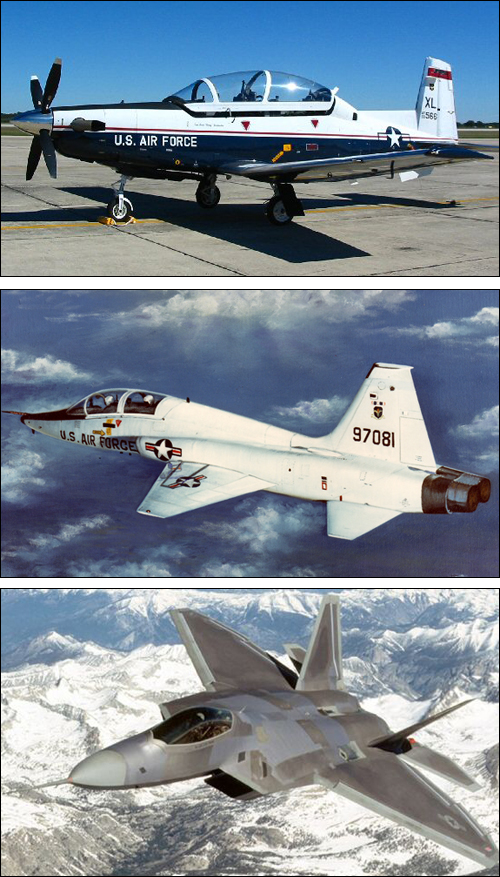
The same concept can be applied to live fire training. Observing fire development and the effect of water application may require a somewhat different context than evolutions involving door entry procedures and integration of fire control and tactical ventilation. In an ideal world, fire service agencies would have access to various types of live fire training props, each suited to providing the best context for specific levels of training and learning outcomes. Container based props and burn buildings may be simple or complex dependent on their intended purpose and learning outcomes that they are designed to support (see Figures 3-5)
Figure 3. Split Level Cell, Palm Beach County Fire Rescue
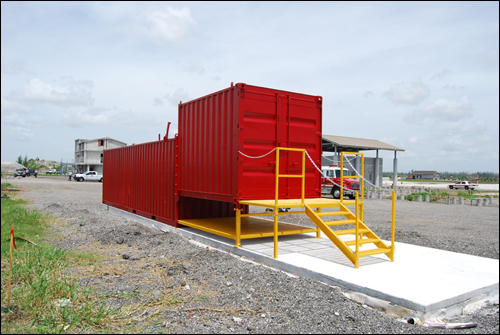
Note: This prop was constructed by Fire Training Structures, LLC and is most effective for demonstrating compartment fire behavior.
Figure 4. Large Volume Container, Swedish Civil Contingencies Agency, Sandö, Sweden
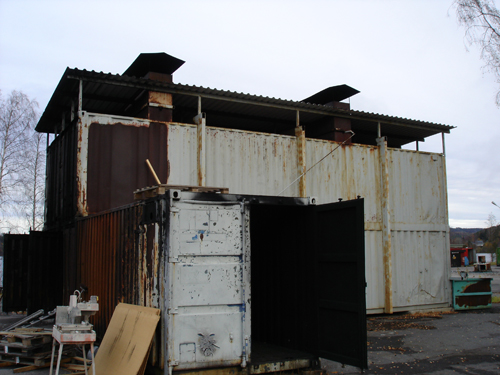
Note: This prop was constructed on site and is designed to demonstrate fire behavior and the impact of tactical operations in large compartments such as found in commercial buildings.
Figure 5. Large Masonry Burn Building, British Fire Service College
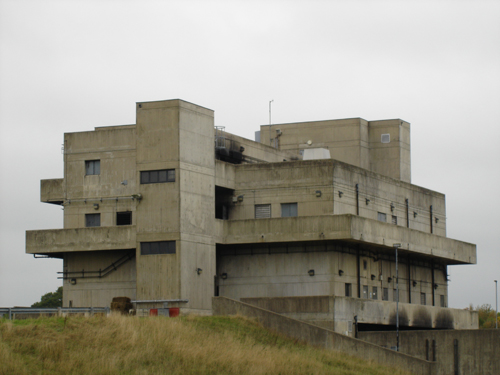
Note: This is one of many live fire training facilities at the college (including container based props and other masonry burn buildings). This building provides an industrial context for advanced firefighter training.
However, for most of us it is not a perfect world. Fire departments faced with limited fiscal resources are often limited in their options for live fire training. If they are fortunate, they have or have access to a purpose built structure that provides a safe and effective environment for a variety of types of live fire training. Each of these types of structures has limitations. The major problem encountered is when instructors and learners believe that the purpose built structure is intended to fully replicate a realistic fire environment as encountered during emergency incidents. It cannot, much the same as a flight simulator cannot fully replicate flying a high performance aircraft. However, it can replicate critical elements of context that help develop knowledge, skill, and a high level of proficiency.
Instructors must 1) identify the intended learning outcomes and critical elements of context necessary to develop learner proficiency to ensure participant safety and 2) recognize both the capabilities and limitations of the props and facilities available.
Other Considerations
Fire departments often face a more difficult challenge than determining what type of prop or facility is most effective or how to best use available facilities. The cost of live fire training is a major concern and unfortunately is often a major determining factor in the availability and type of live fire training conducted. The initial cost for purpose built props and facilities can be a large hurdle with simple commercially built props and structures costing from $40,000 to hundreds of thousands of dollars (or even more for a commercial fire simulator as illustrated in Figure 5). However, initial cost of the prop or facility is the tip of the iceberg. Ongoing costs include fuel, maintenance, as well as instructor and student costs.
While somewhat beyond the scope of this post, environmental considerations and restrictions can also have a significant impact on both design and operation of live fire training facilities and can also have a significant impact on initial and ongoing cost.
The Way Forward
In general, there has not been a concerted and scientifically based effort to determine the critical elements of context required for live fire training. As discussed in Training Fires and Real Fires, live fire training must look real enough (physical fidelity) and react realistically to tactical operations (functional fidelity). However, we have not defined to what extent this is necessary to develop critical skills.
The variety of props, structures, and facilities available for live fire training is substantial, as is the difference in initial, ongoing, and life-cycle cost. While some work has been done comparing these various options, it is often left to individual departments to sort this out without a consistent framework or methodology.
Subsequent posts will examine these two issues in a bit more depth.
Ed Hartin, MS, EFO, MIFireE, CFO
Reference
Garcia, K. & Kaufmann, R. (2009, 2009). Realistic live-burn training you can afford. Fire Engineering, 162(5), 89-93.
Tags: fire behavior, Fire Behavior Training, live fire training, NFPA 1403



June 24th, 2009 at 15:16
I agreed 100% very goog article,cangradulation it,s a lavoratory every think is to controled, heat the work a half tenmperatur, the container ad no defaut no free space qantity of combustible is to low and control the container they call flashover m the made backdraft in it,
whit the floor elevation at the end they cnnot create a reel flashover, anyway they realy dont know what a flashover is,and how is build state by state.The containeur is in steel ,notting ells
That kind of container it give confidence , the firemen but a big one like they have three 3 or 4 stories can be really dangerous,
it to close (to tight close)no defaults, no ventilation,allways the same size 3m x 3m around 50m cu .But it still a good way to practice, and to learn for the biginners,to see something,fire
the very afraid the have in that container it’s to be burns by the steam, cocotte effect, piston effect, it’s all in metal, in a real fire is erery kink of materials,georges
June 25th, 2009 at 14:00
I wrote yesterday and i gorget to read all the aricle. The horizontal ventilation is very danderous just forward of the fire, on the side in the back or in the entry is very badl
For me the only wau to ventilate is on the top the roof I Wrotre a few article on ventilation
The ventilation planified in a cours iT’s all right,
it’s good for the practice,I think It’s necessary to, but it sill a laboratory fire.
In the metal container, it s just metal, in A REAL FIRE WE HAVE ALL KIND OF MATERIAL and now a lot a different emission and absorption, of BTU different level ex 8000 for the wood polyurethan 12,ooo,BTU and polystyren 18,000BTU, it’s a big factor.
For me the best way to practice to extinguish a fire, it a real hold House, excuse me
I wrote to M. Ed Hartin, on the flashover and to Firehouse in the same time, he never answer me. no acknoledgement of receipt
June 27th, 2009 at 06:04
Geroges, While I agree that vertical ventilation can be quite effective, it is not appropriate under all circumstances. Consider a first floor fire in a multi-story building or a contents fire in a single room. These are to examples where roof ventilation may not be the most appropriate approach. Regarding your comments regarding use of container based props, you are correct in that this is a simulation that partially replicates the conditions encountered under actual fire conditions. While use of acquired structures can be much more realistic, this too is a simulation as the types and amount of fuel must be different (if we are compliant with National Fire Protection Association (NFPA) 1403. These types of training exercise may be best used in sequence to safely and effectively develop the firefighters skills. Ed